HOW DOES THE EXTINGUISHER WORK?
The method of starting all fire extinguishers is similar: break the seal and remove the protective pin, point the fire extinguisher hose with the diffuser at the fire and press the knob. Do not take breaks when extinguishing with the ReinoldMax powder extinguisher, and spray the entire contents into the fire with one push of a handle. The 4 kg fire extinguisher has an operating time of 12.7 seconds, so in the event of a serious fire, extinguish the fire, not the flame.Fire is caused by three factors - combustible material, heat and oxygen. The fire is extinguished by removing at least one of the three components. The basis of the ReinoldMax powder fire extinguisher is ABC 50% extinguishing powder, which, when sprayed on a fire, "quenches" the flame and thus separates oxygen. If the fire is larger, extinguish with several ReinoldMax extinguishers at the same time.ReinoldMax powder fire extinguisher is the most popular fire extinguisher in Lithuania due to its high efficiency and fair price. Fire extinguishers of this type effectively extinguish all types of fires and operate at sub-zero temperatures from -30 ° C. When extinguishing a fire indoors or inside a heavy vehicle, be aware that all powder extinguishers form a toxic cloud of dust, so try not to inhale the powder and ventilate the area well after extinguishing. Extinguishing powder is insoluble in water, so it is advisable to vacuum it well and remove the contents immediately.A few minutes after extinguishing, the extinguishing powder may clog the nozzle, so even if you have not sprayed all the contents, immediately add the extinguisher for a new overflow. Make sure the pressure gauge pointer is on the green background.Together with the ReinoldMax fire extinguisher, we recommend purchasing a durable metal bracket for mounting on tractors, buses, trolleybuses, tractors or combines. Rubber supports are built into the bottom and top of the holder, which ensures the stability of the fire extinguisher in the vehicle. The fire extinguisher is secured with two strong straps, which are fastened with adjustable metal buckles. The manufacturer of the fire extinguisher advises that the fire extinguisher be securely fastened to prevent accidental spraying of powder during braking or injury.ReinoldMax powder fire extinguisher is recommended for use in public premises, under construction buildings, heated and unheated warehouses, buses, trucks, combines, garages.
WORK IN EXPLOSIVE ENVIRONMENTS AND CLOTHING FOR THEM
Static electricity generated in clothing causes a discharge that can cause an explosion. There is a risk of spontaneous combustion or spontaneous explosion when working with harmful and volatile substances, and workers must wear clothing that does not become a source of electric arc, electrostatic discharge or shock sparks from which the surrounding explosive mixture will ignite. In this case, special protective antistatic clothing must be worn. Clothing made of antistatic fabric minimizes the risk of explosion due to the accumulation of static electricity. This is necessary to prevent static discharge sparks that can cause self-ignition or explosion.Antistatic clothing does not accumulate static charge. Sewn from antistatic - a specially constructed fabric with a conductive thread that dissipates and ionizes the induced static charge. Static dissipating filaments are carbon or steel sheathed cores woven alongside standard impermeable fabric filaments. We offer clothing that meets the requirements of the European Union for work in the mentioned risk areas.The clothes are tested according to the following EN norms:EN 61482-1-2, class 1 (4Ka) Live working. Protective clothing against thermal hazards caused by electric arcs.EN 1149-5 Protective clothing. Electrostatic propertiesEN 13034 Type 6 Protective clothing against liquid chemicalsEN 11612 A1, A2, B1, C1, E1 Protective clothing. Protective clothing against heat and flameEN 11611, class 1 A1 + A2 Protective clothing is worn during welding and similar processes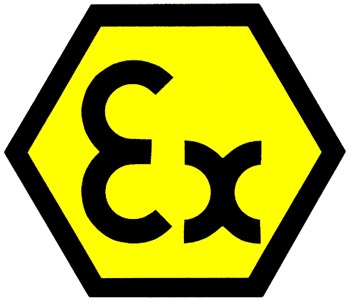
CORDURA
It is a brand that describes fabrics with special properties that make it widely used in military and civilian products with high resistance requirements, such as military and tourism and leisure ammunition, backpacks, clothing, footwear. CORDURA fabric is characterized by durability, strength, abrasion and tear resistance, as well as moisture (impregnated). CORDURA is twice as resistant as nylon and up to ten times more resistant than cotton fabrics. Tissue "viability" tests have shown that CORDURA remains unchanged after 3,000 wash cycles, leaving cotton and nylon far behind.Although CORDURA fabric was developed and registered as a trademark of DuPont in 1929, and was originally used exclusively for military purposes, it is now the property of Invista. CORDURA fabric is usually made of nylon, can be blended with cotton or other natural fibers. Since 1977 the discovery of a way to dye CORDURA fabrics opened up a wide range of commercial applications. As early as 1979. CORDURA fabric occupied 40 percent. market in the production of travel bags. Due to its exceptional resistance to abrasion and heat, CORDURA is also used today by companies such as Klim, Rukka, MotoPort, Rev'It, Olympia, AeroStich, and Dainese in the manufacture of most motorcycle accessories.CORDURA fabric is available in a wide range of shapes, weights and textures, including versions specifically designed to withstand tear and discoloration. There are also base layer, denim and tarpaulin fabrics containing Invista 420 nylon fiber and cotton known as CORDURA Baselayer, CORDURA Denim and CORDURA Duck respectively. The CORDURA Naturalle fabric collection is designed to replicate the feeling of wearing cotton fabric. Some CORDURA fabrics are designed specifically for use in the military and outdoor recreation. CORDURA fabrics have a long history of military application and many samples of U.S. military fabrics are based on CORDURA brand specifications.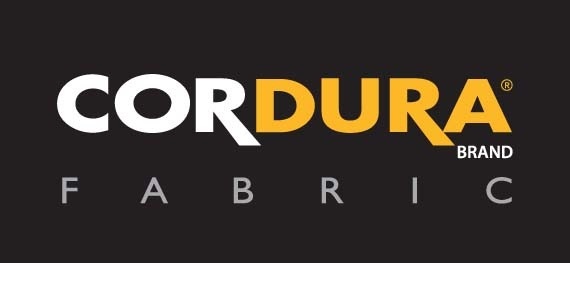
THINSULATE
THINSULATE® - Synthetic fibers, which is an alternative to fur or fluff. Very warm tissue (2 times warmer than the fluff), which is can be used in the manufacture of hats, gloves and shoes warming.Material benefits:· Low absorption and respiratory feature.· Fast drying.· Minimum maintenance.· Fiber is much more lighter and thinner than the polyester.
POLARTEC THERMAL PRO
 Polartec® Thermal Pro® was developed to bring a wider variety of styles and performance functionality to synthetic fleece technologies. By reengineering our construction methods we created an expansive platform of fabric structures with superior benefits over traditional fleece. These unique textures enhance the fabric's overall efficiency and are the defining reason why synthetic fleece will never go out of style as the preferred choice for performance insulation fabrics.BENEFITS
Polartec® Thermal Pro® was developed to bring a wider variety of styles and performance functionality to synthetic fleece technologies. By reengineering our construction methods we created an expansive platform of fabric structures with superior benefits over traditional fleece. These unique textures enhance the fabric's overall efficiency and are the defining reason why synthetic fleece will never go out of style as the preferred choice for performance insulation fabrics.BENEFITS
- Warmth without weight
- Highly breathable
- Fast drying
- Durable
- Easy care
- Available in multiple styles and weights
- Textured weather resistant insulation
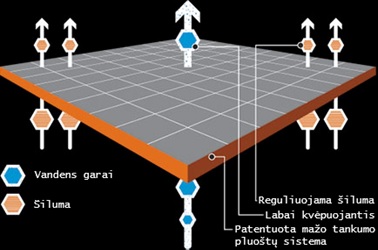
HELLY TECH®
Helly Tech® is a waterproof breathable outer layer between your body and the product. Its unique membrane stops water molecules from entering, but lets moisture molecules out. This allows you to not sweat from the outside and feel comfortable from the inside.How the Helly Tech® system works: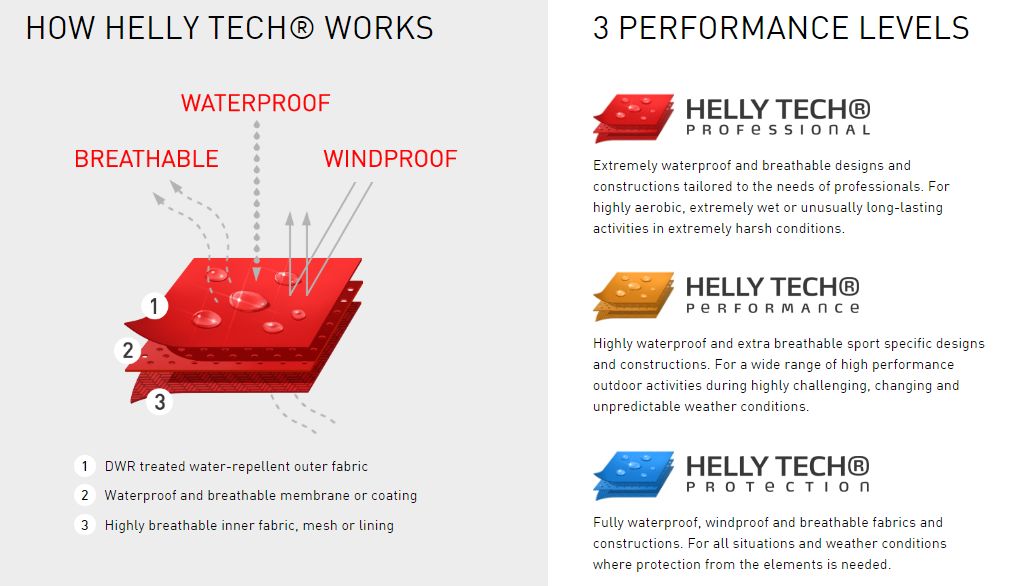
GENERAL INFORMATION ON PERSONAL PROTECTIVE EQUIPMENT (PPE)
Personal Protective Equipment (PPE) in accordance with Directive 89/686 / EEC is intended to protect the consumer. They are divided into three categories.
PPE Category I
Category I includes personal protective equipment that protects the consumer from simple risk factors that can be safely identified in a timely manner without any risk to the consumer. Eg: general wearer protection against dirt. An EC type-examination certificate is not required for products in this category.
PPE Category II
PPE in this category for which the manufacturer or his authorized representative must submit an EC type-examination certificate. The certificate is valid for 5 years. Products in this category protect the consumer from high-risk hazards, such as high visibility or heat protection.
PPE Category III
Products shall protect against fatal hazards or hazards which could cause serious and irreversible damage to health and where, in the opinion of the designer, the consumer does not have sufficient time to assess their direct effects. PPE in this category must be accompanied by an EC type-examination certificate. The certificate is also valid for 5 years only.
EN STANDARDS FOR WORK CLOTHES AND FABRICS
EN 343 European standard setting requirements for PPE to protect against adverse weather conditions.
The standard specifies requirements and test methods for materials and seams for protective clothing against precipitation (eg rain, snow), fog and ground moisture at temperatures up to 5 ° C. The garment has been tested for water resistance (X) and water vapor (Y). The tests are divided into three classes.
Watertightness requirements:
• Class 1 => 8000 Pa before the first fabric treatment
• Class 2 => 8000 Pa after first treatment, and before pre-treatment of fabric and seams
• Class 3 (best protection) => 13000 Pa after pre-treatment of fabric and seams, and before pre-treatment of seams.
Breathing requirements:
• Class 1> 150
• Class 2 20> = 150• Class 3 (best protection) 0> = 20EN 342 Frost protection.

Includes protective products for use by people working in cold conditions in cold stores. This European Standard specifies test methods and requirements for the characteristics of sets of protective clothing (i.e. two-piece suits or overalls) and individual garments. It does not include specific requirements for headgear, footwear or gloves to protect against local cold.
Below is information on the security level. A number, such as 0.47, indicates the measured basic thermal insulation when standing and performing very simple to moderate movements. Data on the use of the respective periods at different ambient temperatures are measured in the table:
 EN 14058 Protection in cold environments.
EN 14058 Protection in cold environments.
The standard defines requirements and test methods for clothing intended to protect the body from cooling in a cool environment (air temperature -5 ° C and above), such as food industry warehouses, factories. In such cases, the clothing does not need to be made of waterproof or non-breathable fabrics. This type of PPE is used to protect the body from the cold environment.
EN ISO 20471: 2013 High visibility clothing.

This standard is intended for clothing requirements designed to ensure personal visibility in hazardous situations, regardless of the lighting conditions during the day or night, under artificial lighting (24-hour visibility). Effective visibility is ensured by the use of fluorescent fabrics and light-reflecting strips. Darkness and poor visibility are major risk factors when working outdoors. Good visibility is a priority for railway, airport and seaport staff. The new standard EN ISO 20471 has replaced the previous standard EN 471, but high visibility garments that are certified according to EN 471 can continue to be sold and worn.
EN 471 High visibility clothing.

The European standard regulates the requirements for reflective materials to be used for high visibility and protective work clothing. The minimum surface of the visible material, i. Fluorescent type material together with light reflecting material is divided into three classes: Class 3 is the highest class, with the highest level of visibility. Class 1 is the lowest visibility class for which a certificate is still issued. The reflective tape is divided into two classes according to the degree of reflection. Class 2 reflective tape is top class.
The upper number in the icon indicates the class of the surface and the reflective material, the number below indicates the class of the reflective material.
EN ISO 11611 will replace the previous standard EN 470-1, Clothing for the protection of welding and similar work.

Clothing made in accordance with EN ISO 11611 helps to protect the wearer when performing welding or other work of a similar nature and with similar risks. Clothing complying with the requirements of this directive protects against splashes (small drops of molten metal) and so-called welding balls, as well as against short-term contact with fire and thermal radiation. Under normal welding conditions, these protective clothing provides limited electrical insulation up to approximately 100 V.
According to EN ISO 11611, garments are divided into the following classes depending on their level of protection:
Class 1 = protection against less hazardous welding operations and situations resulting in lower levels of spraying and radiant heat processes.
Class 2 = protection against more hazardous welding operations and situations involving a higher risk to human health or life.EN 470-1 Clothing for the protection of welding and similar work.

These garments protect against small drops of molten metal (welding balls) and from brief contact with fire. Protective clothing worn during welding and similar processes against heat and flame. This protective clothing will not burn if it is accidentally in contact with a fire source. It protects its wearer from drops of molten metal, but does not necessarily provide protection against larger amounts of liquid metals extracted during various casting operations.
EN ISO 11612 will replace the previous standard EN 531, Protective work clothing for protection against heat.

Protective clothing is designed to provide protection against brief contact with a flame and at least one type of heat source. The heat can be convective, radiant, or caused by large drops of molten metal - or a combination of these effects can occur. The requirements for limited flame spread must always be met.
EN 531 Protective work clothing for protection against heat.

These protective clothing are designed to provide protection against brief contact with a flame and at least one type of heat source. The heat can be convective, radiant, or caused by large drops of molten metal - or a combination of these effects can occur. The requirements for limited flame spread must always be met. Rising oxygen levels in the air reduce the clothing's protection against inflammation. Warning: Limited flame spread is lost if clothing is contaminated with flammable materials. Dirty clothing can have a significant effect on the level of protection.EN 13034 Type 6 protection against chemical liquids.

Protective clothing with limited protection against small sprays (liquid aerosols, sprays) or splashes (low pressure). Liquid protection is not completely complete, so the user must take appropriate protective measures in the event of penetration. Protective clothing is, for example, used in the chemical and oil refining industries, as well as in laboratories. All requirements are assigned to different levels of activity. This is specified in EN 14325 Test methods and operational classification of chemical protective clothing materials, seams, joints and joints. Research tests are performed with reference materials: H2SO4 (30%), NaOH (10%), o-xylene (solvent, undiluted) , butan-1-ol (solvent, undiluted). It must be ensured that the results of tests on different substances are not confused.
Security classes:
H2SO4 = class 3
NaOH = class 3
Grade 3 = r> 95%, p <1%
Grade 2 = r> 90%, p <5%
Class 1 = r> 80%, p <10%
The garment does not provide protection against organic solvents.
EN 1149-3 Protection against electric shock.

Electric load tolerance on the surface of clothing. To remove the charge, a charge is transferred through the materials, as a result of which the charge density or surface potential at the location where the load was most intense is determined. Typical applications are supply companies (eg gas, liquid fuel, fuel), chemical industry, petrol stations, cleaning companies. It is essential to ensure that your entire body is covered (even when wearing clothing under protective clothing), it is forbidden to undress in an explosive environment. Always carry other clothing with you in case of wear and tear. The use of these garments in explosive zone 0 and in the case of explosion group IIC for gas / vapor and air mixtures requires additional protection and specific risk analysis.
EN 1149-5 Type protection against electrostatic charge.
This standard is one of the standard test methods and requirements for a series of protective clothing with electrostatic properties. It defines how to prevent dangerous electrostatic charge leaks. In a combustible environment that is enriched with oxygen, the requirements of this standard may not be sufficient. This standard does not apply to protection against supply voltage.
EN 61482-1-2 Class 1.

The standard was approved based on tests that simulate the effects of a failure at the front of the body at chest height. There is no electrical insulation in the clothes - there is nothing to protect against electric current. Additional protective equipment is recommended (eg gloves, hoods, shield) for complete personal protection. Always carry other clothing with you in case of wear and tear. This type of protective clothing should be worn when working in low voltage environments.GLOVE STANDARDS
EN 420 General requirements for gloves.

This standard specifies general safety, suitability for use and other requirements for protective gloves. Gloves must not present a risk or injury. The pH of the gloves should be as close to neutral as possible.
The pH of leather gloves should be between 3.5-9.5. The maximum level for Chromium is 3 mg / kg body weight (Chromium VI). Specific information must be provided on the materials used in the manufacture of the gloves which may cause allergies. Sizes are based on an agreed common European arm size, for example: small - S.
EN 388: 2016 Resistance to mechanical impact.
Renewal of certificates is mandatory until August 2019, as required by the Personal Protective Equipment Regulation.
EN: 388: 2016 specifies requirements, test methods, markings and information for protective gloves against mechanical hazards, friction, blade cuts, punctures, tears and impact. The friction test and the Coup test from incision were supplemented by 2 test from blade incision and an optional additional impact test.
Below the symbol there are no more 4, but 6 digits. Each of them represents the level of resistance found in tests before a particular effect. The first digit indicates resistance to abrasion, the second to resistance to round blades, the third to tearing, the fourth to puncture, the fifth to resistance to straight blades and the optional six to resistance to impact.
Each test provides a certain level of performance based on five levels of performance. This allows the wearer or health and safety professionals to choose gloves with the right rating. For example, gloves with level 4 abrasion are suitable for handling abrasives and operating heavy equipment. Cutting level 5 indicates high resistance of the glove when cutting metal, glass and other sharp materials. The higher the number, the higher the level of protection.

EN 407 Resistance to thermal hazards.

The degree of safety according to this standard is tested in 6 different types. Each of them is associated with special protective properties. The higher the number, the better the test score.

The tests checked:
1 Flammability.
The glove material has to be stretched and burned by the gas flame. The flame is pressed against the material for 15 seconds. After this time, the length of time the material either glows or burns is measured.
2 Resistance to contact with flame.
The glove material is exposed to temperatures between + 100 ° C and + 500 ° C. It is then measured how long it takes for the material inside the gloves to rise in temperature by 10 ° C from the initial temperature (approximately 25 ° C). 15 seconds is the minimum accepted result. For example, for Class 2 labeling, the inside of the glove material must be heat-resistant at 250 ° C for 15 seconds until the material exceeds 35 ° C.
3 Resistance to air flow heat.
It is time to increase the temperature of the glove's inner material by 24 ° C when exposed to heat from a gas flame (80kW / sqm).
4 Resistance to radiant heat.
The glove material has to be stretched in front of 20-40 kW / sqm heat source. The average time is measured when the heat penetration reaches 2.5 kW / sqm.
5 Resistance to molten metal drops.
The test is based on the calculation of the total number of drops of molten metal which increase the temperature by 40 ° C between the inside of the gloves and the skin.
6 Resistance to molten metal splashes.
The simulated skin is attached from the inside of the gloves. The molten metal is poured through the glove material. The total number of molten metal in grams required to damage the simulated skin is measured.
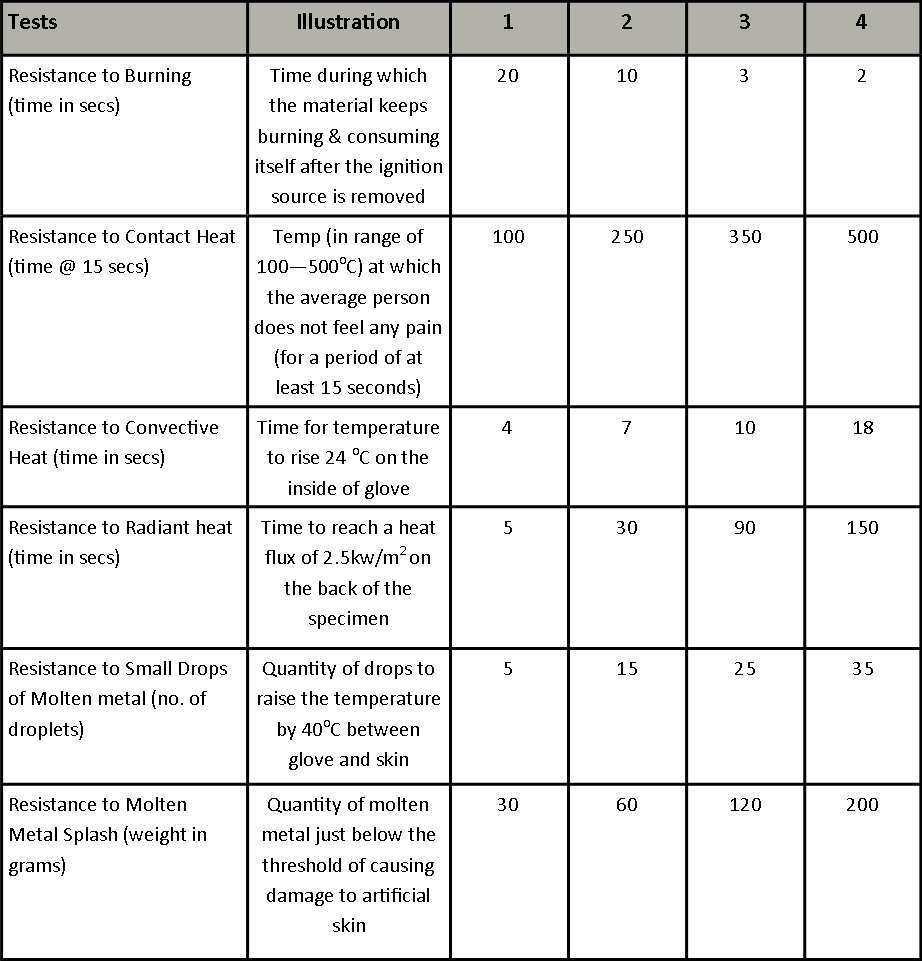 EN 374 Resistance to chemicals and micro-organisms.
EN 374 Resistance to chemicals and micro-organisms.
In many countries of the world there are more than 15,000 different chemicals that are used in more than 60,000 industrial products, construction, agricultural industries. Proven and approved chemical protection gloves are the right solution to protect against these chemicals. You need to know the chemical name of the substance and how long you will be in contact with the chemicals.
(1) The standard specifies that gloves are capable of protecting the user against chemicals and / or micro-organisms. Gloves marked with this icon must be accompanied by a 3-letter code. These letters indicate at least 3 substances (from the list of 12 standard substances) with a breakthrough time of at least 30 minutes. List of 12 standard chemicals:
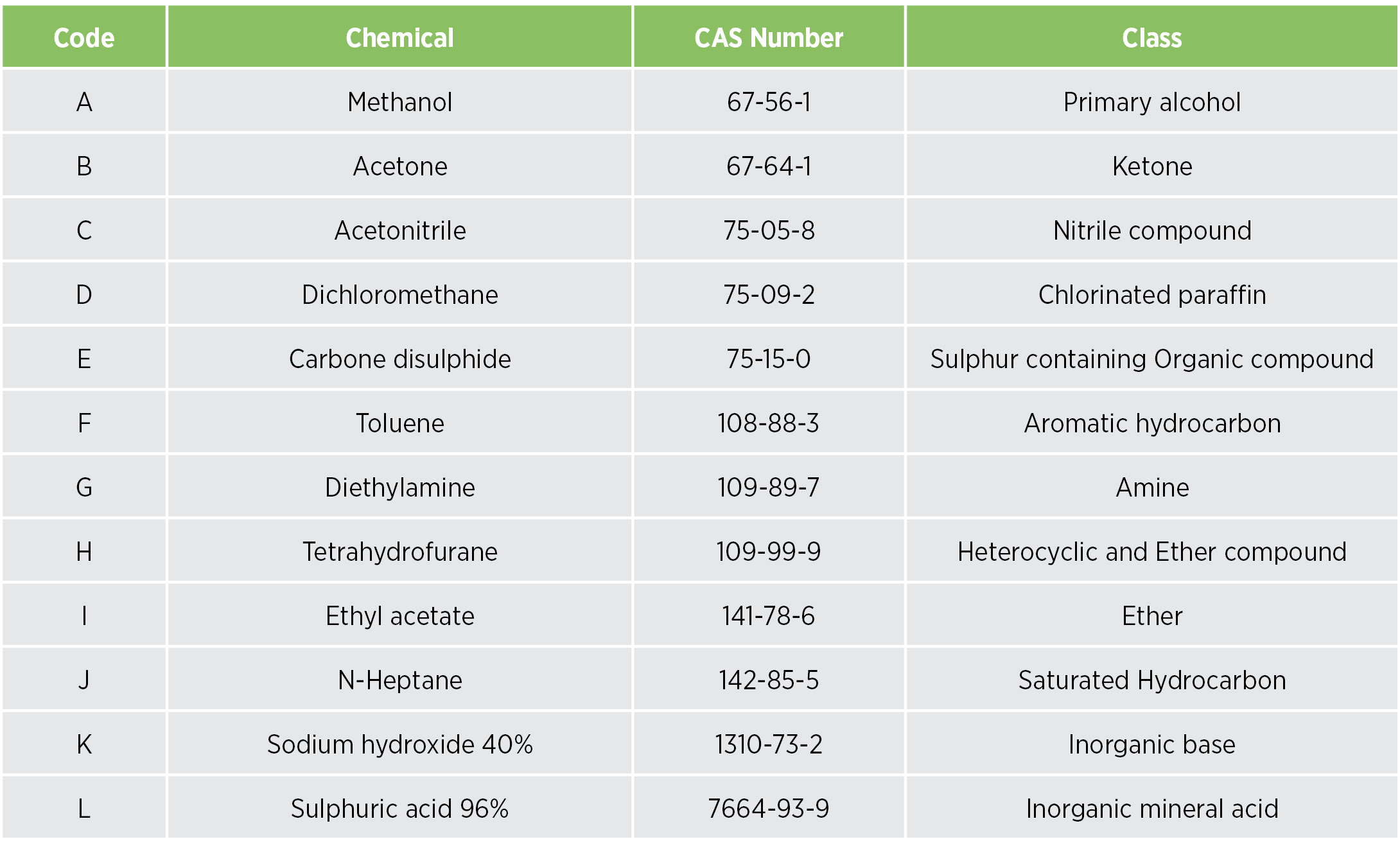
(2) Low resistance to chemicals or waterproof gloves. It is used when the glove does not allow more than 30 minutes of intense penetration of at least three substances from the list.
(3) Resistance to micro-organisms. AQL is an acceptable level of quality. Quality control test to determine the number of substandard glove units from a sample of one hundred units.
The table below will help you choose the right materials from which the glove should be made to protect against different types of chemicals.
 EN 60903 Resistance to electric current.
EN 60903 Resistance to electric current.
You must use special gloves to protect against the dangers of electric shock. Gloves manufactured and approved to EN 60903 are the only gloves that should be worn when there is a risk of electric shock. In order for gloves to provide the best protection, it is important to know what level of voltage level they can withstand.
The table below shows the glove classes and their tolerable different voltage levels. To protect against electric current and against wear and tear, such as sharp cables, a specially designed glove can be worn on EN 60903 gloves.
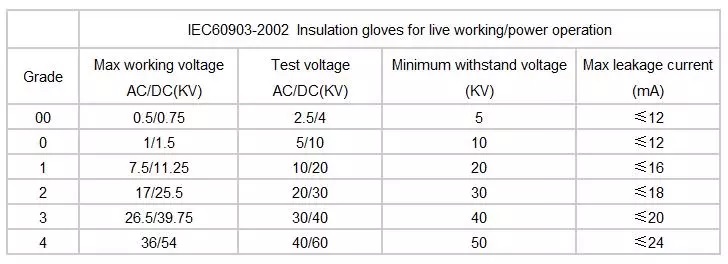
EN 10819 Resistance to vibration.

The standard confirms that gloves should not increase vibrations at moderate frequencies (31.5Hz to 200Hz). High frequency (200Hz to 1250Hz) gloves should reduce vibration levels by 40%.
EN 12477 Welding gloves.
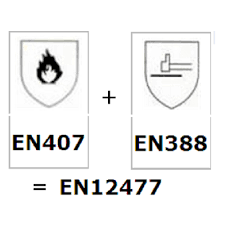
This standard specifies that gloves are designed to provide protection for both hands and wrists during welding or similar work. Standard EN 12477 is a combination of EN 388 and EN 407. Welding gloves provide resistance to small drops of molten metal, short-term effect on convective heat flow. Welding gloves marked with this standard also provide protection against mechanical injuries.
EN 455 Requirements for disposable gloves for medical use.
This standard specifies requirements for disposable medical gloves. The standard defines impermeability, size, strength and thickness. Also maximum flexibility and biosafety features.
EN 511 Frost resistance.

Two things are evaluated according to this standard: 1. How the glove material tolerates cold 2. The material has insulating properties in contact.
The last digit next to the icon indicates whether water is absorbed into the glove after 30 minutes. The icon is accompanied by a 3-digit code.
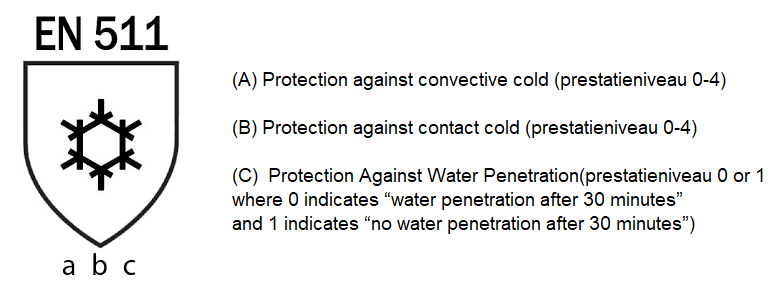
The first digit indicates the convective cold (performance level 0-4).
The second digit indicates resistance during cold contact (performance level 0-4).
The higher the level, the better the insulating properties of the glove.
The third digit indicates the water permeability (operating level 0 or 1).
0 = water penetrates after 30 minutes.
1 = water does not penetrate after 30 minutes.
CLOTHING AND CARE LABELING

MEASUREMENTS OF MASCOT WORKWEAR CLOTHING AND FOOTWEAR

MEASUREMENTS OF REWELLY,CANNYGO AND G-SAFETY CLOTHING
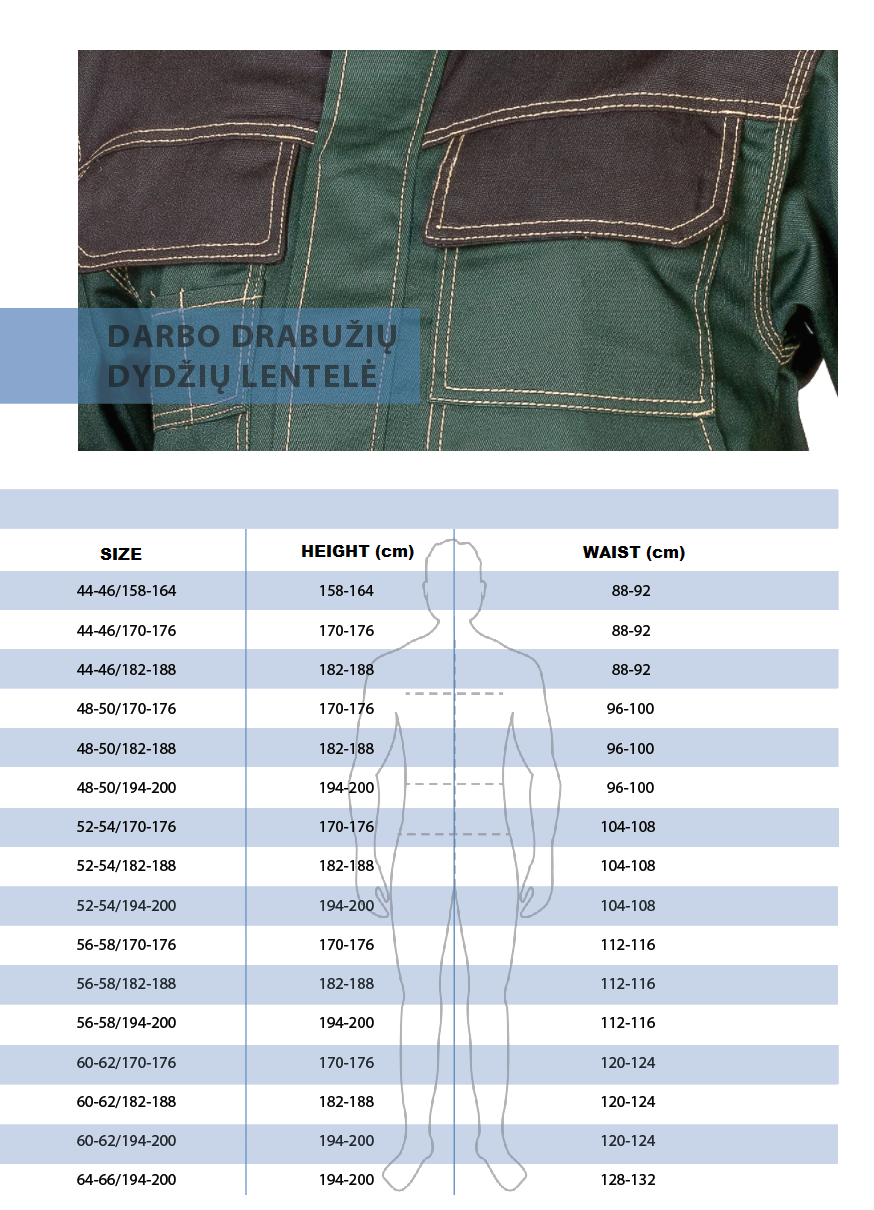
SHOE SIZES AND STANDARDS
Shoe sizes
Basic shoe sizes
|
US |
UK |
EUROPE |
FOOT LENGTH (CM) |
|
6 |
5.5 |
38.5 |
24 |
|
6.5 |
6 |
39 |
24.5 |
|
7 |
6 |
40 |
25 |
|
7.5 |
6.5 |
40.5 |
25.5 |
|
8 |
7 |
41 |
26 |
|
8.5 |
7.5 |
42 |
26.5 |
|
9 |
8 |
42.5 |
27 |
|
9.5 |
8.5 |
43 |
27.5 |
|
10 |
9 |
44 |
28 |
|
10.5 |
9.5 |
44.5 |
28.5 |
|
11 |
10 |
45 |
29 |
|
11.5 |
10.5 |
45.5 |
29.5 |
|
12 |
11 |
46 |
30 |
|
13 |
12 |
47.5 |
31 |
|
14 |
13 |
48.5 |
32 |
|
15 |
14 |
49.5 |
33 |
Men's shoe sizes
|
Foot length (cm) |
23.5 |
24 |
24.5 |
25 |
25.5 |
26 |
26.5 |
27 |
27.5 |
28 |
28.5 |
29 |
29.5 |
30 |
30.5 |
31 |
31.5 |
|
Foot length in inches |
9.3 |
9.4 |
9.6 |
9.8 |
10 |
10.2 |
10.4 |
10.6 |
10.8 |
11 |
11.2 |
11.4 |
11.6 |
11.8 |
12 |
12.2 |
12.4 |
|
Continental Europe |
37 |
37.5 |
38 |
39 |
40 |
40.5 |
41 |
42 |
43 |
43.5 |
44 |
45 |
46 |
46.5 |
47 |
48 |
49 |
|
USA, Canada |
5 |
5.5 |
6 |
6.5 |
7.5 |
8 |
8.5 |
9 |
9.5 |
10 |
11 |
11.5 |
12 |
12.5 |
13 |
14 |
14.5 |
|
UK, Australia |
4 |
4.5 |
5.5 |
6.5 |
7 |
7.25 |
7.75 |
8 |
8.5 |
9 |
9.5 |
10.5 |
11 |
11.5 |
12 |
12.5 |
13 |
|
Japan |
23.5 |
24 |
24.5 |
25 |
25.5 |
26 |
26.5 |
27 |
27.5 |
28 |
28.5 |
29 |
29.5 |
30 |
— |
— |
— |
|
Russia |
36 |
37 |
38 |
38.5 |
39 |
40 |
40.5 |
41 |
42 |
42.5 |
43 |
44 |
44.5 |
45 |
46 |
46.5 |
47 |
|
France |
36.5 |
37 |
37.5 |
38 |
39 |
40 |
41 |
42 |
42.5 |
43 |
44 |
45 |
46 |
46.5 |
47 |
47.5 |
48 |
|
China |
37 |
39 |
40 |
41 |
42 |
43 |
44 |
45 |
46 |
47 |
47.5 |
48 |
— |
— |
— |
— |
— |
|
Korea |
235 |
240 |
245 |
250 |
255 |
260 |
265 |
270 |
275 |
280 |
285 |
290 |
295 |
300 |
305 |
310 |
315 |
|
Mexico |
— |
4.5 |
5 |
6 |
6.5 |
7 |
8 |
9 |
10 |
10.5 |
11.5 |
12.5 |
13 |
14 |
14.5 |
15.5 |
— |
Women's shoe sizes
|
Foot length (cm) |
21.5 |
22 |
22.5 |
23 |
23.5 |
24 |
24.5 |
25 |
25.2 |
30 |
30.5 |
31 |
31.5 |
32 |
32.5 |
33 |
33.5 |
|
Foot length in inches |
8.5 |
8.7 |
8,9 |
9.1 |
9.3 |
9.4 |
9.6 |
9.8 |
9.9 |
11.8 |
12 |
12.2 |
12.4 |
12.6 |
12.8 |
13 |
13.2 |
|
Continental Europe |
34 |
34.5 |
35 |
36 |
37 |
37.5 |
38 |
39 |
39.5 |
40 |
40.5 |
41 |
42 |
43 |
43.5 |
44 |
45 |
|
USA, Canada |
3.5 |
4 |
5 |
5.5 |
6 |
6.5 |
7 |
7.5 |
8 |
8.5 |
9 |
9.5 |
10 |
10.5 |
11 |
12 |
12.5 |
|
UK |
— |
— |
2.5 |
3 |
3.5 |
4 |
4.5 |
5 |
5.5 |
6.5 |
7 |
7.5 |
8 |
9.5 |
10.5 |
11.5 |
13 |
|
Japan |
21.5 |
22 |
22.5 |
23 |
23.5 |
24 |
24.5 |
25 |
25 |
25.5 |
26 |
26.5 |
27 |
27.5 |
28 |
28.5 |
29 |
|
Russia |
— |
— |
34 |
34.5 |
35 |
36 |
37 |
38 |
39 |
40 |
41 |
42 |
43 |
43.5 |
44 |
— |
— |
|
France |
— |
— |
35 |
35.5 |
36 |
37 |
37.5 |
38 |
38.5 |
39 |
40 |
41 |
42 |
43 |
44 |
— |
— |
|
Australia |
— |
— |
3.5 |
4 |
4.5 |
5.5 |
6 |
6.5 |
7 |
7.5 |
8.5 |
9 |
10.5 |
11 |
11.5 |
12.5 |
14 |
|
Mexico |
— |
— |
— |
— |
— |
— |
4.5 |
5.5 |
6 |
6.5 |
7 |
7.5 |
8 |
9 |
10 |
11 |
12.5 |
|
China |
35 |
35 |
35.5 |
36 |
37 |
38 |
39 |
40 |
40.5 |
41 |
42 |
43 |
44 |
45 |
46 |
47 |
49 |
|
Korea |
— |
220 |
225 |
230 |
235 |
240 |
245 |
250 |
— |
255 |
260 |
265 |
270 |
— |
— |
— |
— |
Safety standards for work footwear
EN ISO 20345
SB Minimum requirements (harmlessness, comfort, strength, shoe toe resistant to impact and compression 200 J)
S1 SB + closed heel + antistatic footwear + energy absorption in the shoe sole + oil and fuel resistant sole
S1P S1 + sole puncture resistance
S2 S1 + waterproof shoe upper
S3 S2 + sole puncture resistance + studded sole
S4 Basic requirements + antistatic properties, energy absorption in the heel area
S5 S4 + puncture resistance of the shoe base, sole with a raised edge
Marking of safety shoes
A Antistatic footwear
AN Ankle protection
CI Cold insulation
E Energy absorption in the shoe sole
ESD Static energy absorption
FO Pad is resistant to oil and fuel
HI Heat insulation
M Foot protection
MT Additional protection of the top of the shoes against 100J energy
P Puncture resistance of the sole
SRA Slip resistance on wet ceramic tiles + soapy water
SRB Slip resistance on smooth steel with glycerine
SRC SRA + SRB
WR Water resistance
WRU Waterproof shoe upper
HRO 300°C heat resistant sole
Rewelly Light colection work clothes size chart

